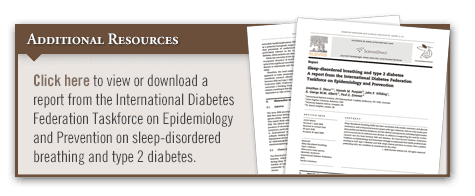In clinical research, sleep disordered breathing conditions like obstructive sleep apnea (OSA) have been associated with insulin resistance and glucose intolerance. OSA is typically characterized by loud snoring and pauses in breathing while sleeping. Excess weight is often considered the cause of OSA because fat deposits around the upper airways obstruct breathing. Obesity has been identified as a significant risk factor for OSA as well as diabetes, but studies suggest that obesity status is not the only determinant. Also, diabetes itself is a major risk factor and complication of OSA. In addition to causing poor sleep quality and daytime sleepiness, OSA has other important clinical consequences, including an increased risk of hypertension and cardiovascular disease (CVD).
Despite the significant burden that OSA and other sleep disorders has on patients, these health problems are not well recognized by clinicians. “OSA is commonly found in people with type 2 diabetes, but clinicians need to ask their patients about daytime drowsiness, snoring, and impaired sleep symptoms in order to identify the problem,” says Daniel Einhorn, MD, FACP, FACE. He notes that the link between OSA and type 2 diabetes has important clinical, epidemiologic, and public health implications. “When OSA is treated appropriately, it’s possible to prevent serious health problems,” he says. “This is particularly relevant in the context of coexisting type 2 diabetes, when patients are already at significant risk of CVD.”
Understanding the Clinical Picture
Sleep-disordered breathing encompasses several characteristic complications (Table 1). Other symptoms and associated clinical disorders are seen more commonly in those with OSA than would be expected by chance. “Sleep apnea can decrease quality of life,” says Dr. Einhorn. “It can also worsen diabetes and increase the risk of developing diabetes or other serious health problems.” While men and women areboth at risk for OSA, older men appear to be at greater risk. Studies indicate that two of every three men with diabetes over the age of 65 have sleep apnea.
Treatments for OSA
Lifestyle changes are among the most important treatments for mild cases of OSA, but other therapies are more effective for moderate-to-severe cases. These include continuous positive airways pressure (CPAP) devices, oral appliances, and surgery (Table 2). “CPAP devices have been used to treat OSA for many years, but many patients in the past did not want to use them because older models were uncomfortable, cumbersome, and loud,” says Dr. Einhorn. “Fortunately, advances in technology have made CPAP devices more patient friendly. The current generation of equipment is much easier for patients to use.” If patients previously tried CPAP but found that it was too difficult to endure, they should try again with some of the newer devices that are currently available.
According to Dr. Einhorn, treating OSA can lead to many significant health improvements in patients with diabetes while also enhancing quality of life. “Patients may be apprehensive about treatments for OSA, but the reality is that doing so will improve many aspects of health,” he says. “Treating OSA can improve glycemic control and insulin resistance and help with CVD markers and weight gain.”
Getting Proactive
Clinical guidelines recommend that clinicians ask their patients with diabetes about any sleeping problems they may experience. “Patients with diabetes should be asked about their sleep quality and whether or not they snore, especially if they’re overweight,” Dr. Einhorn says. “A sleep study may be helpful if OSA is suspected. These studies used to be more cumbersome because patients needed to be monitored overnight in a laboratory. Now, we have devices available that allow patients to go home and sleep in their own bed while they’re being monitored for sleep disorders.”
Experts in diabetes have called for increased awareness and research with respect to OSA and type 2 diabetes. They recommend that all health professionals involved with diabetes or OSA be educated about the links between the two conditions (Table 3). “OSA and diabetes cause significant financial and disability burden to patients,” says Dr. Einhorn. “Clinicians should ask about sleep hygiene regularly during patient encounters so that these problems can be managed as early as possible. Treating OSA can have important implications on how well patients control their diabetes.”




 TimH
TimH